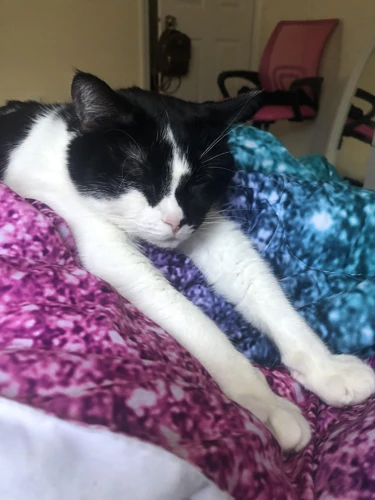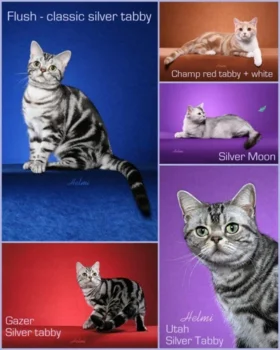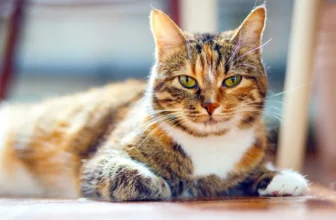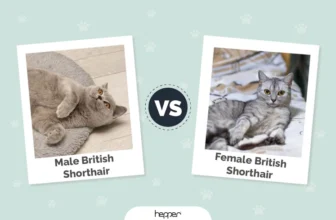As a cat owner, you might have experienced the peculiar behavior of your American Shorthair getting incredibly hyperactive during the night. They may run around, jump, and play with imaginary friends, leaving you wondering what on earth their nighttime crazies are all about. It’s fascinating to watch, but it can also be challenging when you’re trying to sleep, and your cat insists on keeping you up all night. In this article, we will dive into the reasons behind this behavior and provide you with actionable steps to help eliminate your American Shorthair’s nighttime crazies. So, let’s get started!
Understanding the Behavior

As a cat owner, it’s important to understand your furry friend’s behavior and what triggers their actions. American Shorthairs, like many other feline breeds, exhibit certain behavioral patterns that can cause concern for owners, especially when it comes to their nighttime activity. To help you better understand this behavior and how to address it, we’ll explore why American Shorthairs get “nighttime crazies,” whether it’s a common trait for this breed, and the potential dangers associated with it. By the end of this section, you’ll be well-equipped with the knowledge you need to help manage your feline friend’s nighttime activity.
Why Do American Shorthairs Get Nighttime Crazies?
According to experts, American Shorthairs (AS) get nighttime crazies due to their innate hunting instincts. They are natural predators, and during the day, they usually sleep to conserve energy. At night, when they are more alert and awake, their predator instinct kicks in, and they become more active.
AS is inherently active, and they require sufficient physical activity to expend their energy. When they lack enough exercise and interactive playtime, they become restless and exhibit unwanted jumping habits, scratching furniture or door frames, meowing loudly, and zooming around the house during the night.
Another reason why your AS may have nighttime crazies is that they may be hungry, thirsty, or bored. Thus, they will wander around the house, looking for things to do. If they are thirsty, they may knock over the water bowl to get your attention, and when they are hungry, they may meow loudly or beg for food. That being said, it is essential to address their basic needs and minimize their boredom.
American Shorthairs are also naturally curious, and they get stimulated by their environment. So, when they hear noise or see unfamiliar movements, they will be more aggressive, zooming around the house, and meowing loudly. That’s why it’s essential to make their sleeping environment calm and comfortable to reduce stimulation and avoid noisy activities that can disturb their sleep.
These are some of the reasons why American Shorthairs get nighttime crazies. Addressing these underlying issues can prevent them from running around the house at night and engaging in unwanted activities.
Is Nighttime Activity Common for American Shorthairs?
Is Nighttime Activity Common for American Shorthairs?
American Shorthairs are known to be active and playful cats, and it is not uncommon for them to exhibit nocturnal behavior. This means they tend to be more active during the night, which can be due to their natural instincts or boredom. However, this behavior can often be disruptive to their owners, causing them to lose sleep and putting the cat in potential danger.
To understand if your American Shorthair’s nighttime crazies are normal, here are some behaviors to look out for:
- Pacing and running around the house
- Jumping on furniture and knocking things over
- Excessive meowing or yowling
- Scratching on furniture or doors (Check out how to stop American Shorthair scratching furniture)
- Waking up their owners repeatedly
If your cat exhibits any of these behaviors, then it is likely that they are experiencing nighttime activity more than usual. Although it may be cute to watch at times, these nighttime crazies can end up being problematic for both you and your cat. So, it’s important to take steps to prevent and manage this behavior.
To learn more about managing and preventing your American Shorthair’s nighttime crazies, keep reading. Additionally, to teach your American Shorthair to play nicely with you during playtime, take a look at train American Shorthair playtime. And, to avoid other annoying cat behaviors like constant meowing, check out American Shorthair stop meowing.
Dangers of Nighttime Activity for American Shorthairs
It’s important to understand the potential dangers of letting your American Shorthair roam free at night. Here are some of the risks to keep in mind:
- Injury: American Shorthairs are natural hunters, with a strong instinct to pounce and play with anything that moves. This can put them at risk of injury if they encounter any sharp or dangerous objects while exploring at night.
- Outdoor predators: There is always a risk of outdoor predators such as coyotes, raccoons, and even other cats, attacking your American Shorthair if they are left outside at night.
- Car accidents: Cats can be hard to see in the dark, and drivers may not see them until it’s too late. American Shorthairs who roam at night have a higher risk of getting hit by a car.
- Lost or stolen: If your American Shorthair is allowed to roam outside at night, they may wander too far and get lost or even stolen.
- Exposure to disease: Outdoor cats are exposed to more diseases and parasites from other animals. Your American Shorthair could easily contract parasites such as fleas or ticks and even more dangerous diseases such as feline leukemia or rabies.
Given these potential dangers, it’s best to take steps to prevent your American Shorthairs from experiencing nighttime crazies. By ensuring they have plenty of stimulation and a safe, calm environment, you can help keep your pet happy and healthy.
Preventing Nighttime Crazies

As American Shorthairs are known for their energetic personalities, it’s not uncommon for them to experience bouts of hyperactivity, especially during nighttime. These episodes, commonly known as the “nighttime crazies,” can be challenging to deal with and disruptive to both your sleep patterns and your furry friend’s well-being. However, there are several ways to prevent these episodes from occurring and help your American Shorthair relax and settle into a peaceful sleep. Let’s delve into some practical tips that can help you prevent your furry friend’s nighttime crazies.
Daily Playtime
Regular playtime is an important step in preventing your American Shorthair from getting nighttime crazies. Playtime not only helps your cat burn off excess energy but also stimulates their mind. However, it is essential to understand that not every play session needs to be high energy or active. Some cats may prefer a calm or gentle play session. It is imperative to find what type of play your American Shorthair responds to best.
Types of Play:
| Type of Play | Description |
|---|---|
| Interactive Play | This type of play involves you and your cat. Interactive play activities can include playing with a feather wand or throwing a toy mouse. |
| Solo Play | These toys can be left out for your cat to play with on their own. Examples of solo-play toys are balls, cardboard boxes, or stuffed animals. |
| Puzzle Toys | Puzzle toys are toys that require your cat to work for their treat or food. Examples of puzzle toys are mouse feeders or treat balls. |
Frequency:
Cats need daily playtime, but the frequency and duration vary on the age and personality of your cat. Kittens require more playtime than adult cats, and senior cats may not have as much energy. Generally, 15-30 minutes of playtime daily is recommended, but the amount can be split into multiple sessions throughout the day.
Benefits of Playtime:
Playtime serves as a stress-relief for cats. It helps reduce boredom and prevents destructive behavior such as scratching or chewing on furniture.
By understanding your American Shorthair’s needs, you can provide them with the best playtime experience. Remember, playtime should be fun and safe for both you and your cat.
Interactive Toys
Interactive toys are a great way to keep your American Shorthair entertained and prevent nighttime crazies. There are many different types of interactive toys available, so it’s important to choose ones that your cat will enjoy and engage with.
Types of Interactive Toys
| Type of Toy | Description |
|---|---|
| Puzzle feeders | These are toys that dispense food or treats as your cat plays with them. Puzzle feeders stimulate your cat’s natural instincts to hunt for food and can provide mental stimulation as well as physical activity. |
| Wand toys | These are toys that generally consist of a long stick with a string or feather attached to the end. You can use wand toys to play with your cat and encourage them to jump, pounce, and otherwise move around. |
| Tunnels | Cats love to hide and play in tunnels, and there are many different types of cat tunnels available. Some are simple and collapsible for easy storage, while others are more elaborate and offer multiple levels or hiding spots. |
| Automatic lasers | These are toys that project a laser beam that moves around randomly, encouraging your cat to chase and pounce on it. Automatic lasers are a great way to provide exercise and mental stimulation for your cat even if you’re not able to play with them directly. |
Benefits of Interactive Toys
Interactive toys provide several benefits for your American Shorthair, including:
- Physical activity: Interactive toys encourage your cat to move around and exercise, which can help prevent obesity and related health problems.
- Mental stimulation: Many interactive toys challenge your cat’s problem-solving skills and stimulate their brain, which can prevent boredom and related behavioral issues.
- Bonding: Playing with your cat using interactive toys can strengthen your bond and improve your relationship.
Tips for Using Interactive Toys
When using interactive toys with your American Shorthair, keep these tips in mind:
- Rotate your cat’s toys regularly to prevent boredom.
- Supervise your cat when playing with wand toys or other toys that could become a choking hazard.
- Choose toys that are appropriate for your cat’s age and size.
By incorporating interactive toys into your American Shorthair’s playtime routine, you can help prevent nighttime crazies and provide them with the exercise and mental stimulation they need to stay healthy and happy.
Scratching Posts
Providing your American Shorthair with appropriate opportunities to scratch is essential in preventing nighttime crazies. Scratching is a natural behavior for cats that helps them stretch, mark their territory, and keep their claws healthy. If your cat is scratching inappropriate objects like furniture or walls, it can be a sign that it needs a designated scratching post.
Choosing the Right Scratching Post
Not all scratching posts are created equal, and it’s important to choose one that your cat will actually use. Here are some factors to consider when choosing a scratching post:
| Factor | Considerations |
|---|---|
| Height | The post should be tall enough for your cat to fully stretch while scratching. |
| Material | Cats have different material preferences for scratching. Some might prefer carpeted posts, while others might prefer sisal or cardboard. |
| Sturdiness | The post should be sturdy enough so that it won’t tip over or wobble while your cat is scratching. |
| Location | It’s important to place the scratching post in a visible and accessible location where your cat spends most of its time. |
Encouraging Use
Once you have chosen the right scratching post for your American Shorthair, you can encourage its use by:
– Placing the post in a desirable location
– Sprinkling catnip on the post to make it more appealing
– Using positive reinforcement like treats when your cat uses the post
– Redirecting your cat’s attention to the post when it starts scratching inappropriate objects
By providing your American Shorthair with an appropriate scratching post and encouraging its use, you can help prevent nighttime crazies and promote healthy scratching habits.
Feeding Routines
Maintaining a consistent feeding routine is crucial in eliminating your American Shorthair’s nighttime craziness. It can help establish a predictable pattern that your cat can rely on, reducing anxiety and stress.
Here are some tips for establishing a feeding routine that works:
- Feed your cat at the same time every day. This will help establish a predictable schedule that your cat can follow.
- Avoid feeding your cat right before bedtime. If possible, try to leave a few hours between the last meal and bedtime, as this can help reduce the likelihood of nighttime activity.
- Provide small frequent meals throughout the day. This can keep your cat satisfied and prevent them from overeating, which can lead to nighttime activity.
- Choose a high-quality cat food that meets your cat’s nutritional needs. Talk to your vet about the best options for your cat.
- Use puzzle feeders or food dispensers to make mealtime more engaging. This will help stimulate your cat’s mental and physical activity during the day, reducing the need for nighttime play.
Remember, establishing a consistent feeding routine is just one step in eliminating your American Shorthair’s nighttime crazies. It’s essential to combine this with other measures, such as daily playtime and creating a calm sleeping environment, to help your cat feel relaxed and tired at night. By doing so, you can help your furry friend get a good night’s rest and keep their energy levels in check throughout the day.
Creating a Calm Sleeping Environment
To prevent the American Shorthair’s nighttime crazies, it’s necessary to create a calming sleeping environment. Here are some tips to ensure your cat has a peaceful sleep:
- Provide a comfortable bed: Choose a cozy, comfortable bed that your cat loves to sleep in. Cats prefer beds that are soft and warm, so opt for one that is made of plush material or has a soft blanket.
- Keep the sleeping area quiet: Make sure the area around your cat’s bed is calm and quiet. Avoid placing the bed near loud appliances or in areas with heavy foot traffic.
- Control the lighting: Cats are sensitive to light, and bright lights can make it difficult for them to sleep. Use dim lighting at night to create a calming atmosphere.
- Use soothing scents: Consider using scents that are known to have a calming effect on cats, such as lavender or chamomile. You can use essential oils in a diffuser or simply sprinkle dried herbs in the bedding.
- Make the sleeping area cozy: Ensure the sleeping area is warm, cozy, and secure. Use a soft blanket or cushion to create a cozy nest for your cat to snuggle up in.
By providing a comfortable and safe sleeping environment, your cat will be more likely to sleep peacefully through the night. This can help reduce their nighttime crazies and improve their overall behavior.
Exercise and Training
One of the most effective ways to eliminate your American Shorthair’s nighttime crazies is through exercise and training. Providing your cat with ample physical and mental stimulation during the day can tire them out and reduce their likelihood of getting hyperactive at night. Here are some tips on how to incorporate exercise and training into your cat’s routine:
1. Playtime: Dedicate a few minutes of your day to play with your American Shorthair. Some activities that your cat might enjoy include chasing strings, batting around toys, and playing with catnip balls. You can also invest in interactive toys such as laser pointers and puzzle toys.
2. Leash Training: Some American Shorthairs can be trained to walk on a leash. This activity allows your cat to explore the outdoors safely while getting some exercise. Start by fitting your cat with a harness rather than a collar, as collars can be dangerous if your cat gets tangled up. Begin by walking your cat indoors and then gradually introduce short outdoor walks. Always supervise your cat and never leave them unattended outside.
3. Obstacle Course: Set up an obstacle course in your home using boxes, tunnels, and other items. This activity can be a fun way for your cat to exercise while also stimulating their cognitive abilities.
4. Feeding Toys: Feeding toys such as food puzzles and treat dispensers can provide both physical and mental stimulation for your cat. These toys require your cat to work for their food, which can tire them out and reduce their energy levels at night.
5. Training Sessions: You can also train your American Shorthair to perform basic commands such as sit, stay, and come. Positive reinforcement training using treats and praise can be an effective way to engage your cat and build a bond with them.
Incorporating exercise and training into your cat’s routine can provide them with a fun and healthy outlet for their energy. Remember to always supervise your cat during playtime and training sessions, and never punish them for exhibiting nighttime crazies. By providing your American Shorthair with a stimulating environment during the day, you can help them sleep through the night peacefully.
Additional Tips
Now that you understand the reasons behind your American Shorthair’s nighttime crazies and have learned some practical prevention tips, it’s time to delve deeper into additional tips that can help you manage this behavior. While each cat’s behavior is unique, there are additional strategies and resources available that can benefit any cat owner. In this section, we will explore various ways to address your American Shorthair’s excessive nighttime activity with the goal of improving your cat’s overall wellbeing. So, let’s dive in and discover what else you can do to eliminate your cat’s nighttime crazies.
Consulting with Your Vet
As a cat owner, you want to ensure that your American Shorthair is healthy and happy. If you have tried all the tips mentioned earlier and your cat is still exhibiting nighttime crazies, it might be time to consult with your vet.
Why Consult with Your Vet?
Your vet is an expert when it comes to cats and their behavior. Consulting with them will help you understand why your cat is experiencing nighttime crazies and what you can do to help them. Your vet can also rule out any underlying medical conditions that may be causing this behavior.
What Will Your Vet Do?
During your vet appointment, you can expect them to perform a physical examination on your cat. They will also ask you questions about your cat’s behavior, diet, and lifestyle. It’s important to be as detailed and honest as possible when answering these questions.
Your vet may also recommend blood work or other diagnostic tests to rule out any underlying medical conditions that may be causing this behavior. If there are no medical concerns, they may recommend behavioral training or medication to help manage your cat’s nighttime crazies.
When Should You Consult with Your Vet?
If your cat’s nighttime crazies are getting worse or persisting despite your efforts to prevent them, it’s time to consult with your vet. Additionally, if your cat is exhibiting any other unusual behaviors or showing signs of illness or discomfort, a visit to the vet is recommended.
Consulting with your vet will help you better understand your cat’s behavior and ensure that they are healthy and happy. Don’t hesitate to make an appointment if you are concerned about your cat’s nighttime activity.
| Reasons to consult with your vet | What your vet will do | When to consult with your vet |
|---|---|---|
| Understand your cat’s behavior | Perform a physical exam, ask questions, and recommend diagnostic tests or treatment | If nighttime crazies persist despite prevention efforts or if your cat is showing signs of illness or discomfort |
| Ruling out any underlying medical conditions | Recommend behavioral training or medication to manage nighttime crazies | If your cat’s nighttime crazies are getting worse |
Behavioral Training
Behavioral training can be a valuable tool in managing your American Shorthair’s nighttime crazies. It involves teaching your cat new behaviors and reinforcing positive ones through rewards and positive reinforcement. Here are some strategies you can use to train your cat and promote good behavior:
| Strategy | Description |
|---|---|
| Clicker training | Clicker training involves using a clicker device to signal to your cat when they have performed a desired behavior. You then reward them with a treat or praise. Over time, your cat will associate the click with a positive outcome and will be more likely to repeat the desired behavior. |
| Positive reinforcement | Positive reinforcement involves rewarding your cat for good behavior with treats, praise, or playtime. This can help encourage your cat to engage in positive behaviors and may discourage nighttime crazies. |
| Redirecting behavior | If your cat is engaging in unwanted behaviors at night, like scratching or biting, you can redirect their attention to another activity, like playing with a toy or using a scratching post. This can help break the cycle of nighttime craziness. |
| Consistency | One of the most important aspects of behavioral training is consistency. You should use the same rewards and discipline techniques every time your cat engages in a certain behavior. This will help your cat learn which behaviors are acceptable and which are not. |
Using these strategies, you can help your American Shorthair develop good habits and manage their nighttime crazies effectively. It may take some time and effort, but with patience and consistency, you can help your cat become a well-behaved and happy member of your household.
Avoiding Punishment
It’s important to avoid punishing your American Shorthair for exhibiting nighttime crazies. Punishment can cause stress and anxiety, which can worsen the behavior. Instead, try redirecting your cat’s behavior with interactive toys or providing a designated play area.
Here are some tips to avoid punishment:
- Avoid yelling or hitting your cat when they exhibit the behavior.
- Instead, provide them with toys or activity to discourage the behavior in a positive way.
- Keep in mind that cats do not understand punishment as we do – they simply see it as negative attention.
- Consider consulting with a veterinary behaviorist for more guidance on how to handle the behavior without punishment.
Remember, punishment is not an effective way to eliminate the behavior, and can actually worsen it. Instead, focus on positive reinforcement and providing an environment that promotes healthy behavior.
Setting Consistent Routines
Setting consistent routines is an important aspect of managing your American Shorthair’s nighttime crazies. By doing so, you can ensure that your cat knows what to expect each day and night, minimizing the likelihood of erratic behavior.
One key area where consistency is essential is in your cat’s feeding routine. Try to feed your American Shorthair at the same time each day, and stick to a regular portion size. This can help to regulate their metabolism, ensuring that they are not overly hungry or wired at night.
Another important aspect of setting consistent routines is in your cat’s playtime. Dedicate a specific time each day to play with your cat, using interactive toys to engage their natural hunting instincts. This not only helps to burn off excess energy, but also promotes bonding between you and your furry friend.
Consider implementing a consistent sleep routine for your American Shorthair. Create a calm sleeping environment by providing a comfortable bed and ensuring that the room is free from loud noises and bright lights at night. This will help your cat to relax and feel secure during their sleeping hours.
To summarize, setting consistent routines in your cat’s feeding, playtime, and sleep habits can go a long way in reducing their nighttime crazies. By establishing a predictable schedule, you can provide your American Shorthair with a sense of security and stability, which can translate to calmer behavior throughout the day and night.
| Ways to Set Consistent Routines | Benefits for Your American Shorthair |
|---|---|
| Feeding routine: Regular feeding times and portion sizes | Regulates metabolism and prevents excessive hunger or hyperactivity at night |
| Playtime routine: Designated playtime every day using interactive toys | Burns off excess energy and promotes bonding with owner |
| Sleep routine: Creating a calm sleeping environment | Helps the cat to relax and feel secure, leading to better behavior overall |
Conclusion
In conclusion, dealing with an American Shorthair’s nighttime crazies can be a challenging experience for pet owners. However, by understanding their behavior, providing them with the right resources, and implementing training and exercise routines, owners can keep their pets healthy and happy.
It is important to remember that American Shorthairs are just like any other cat breed, and their nighttime activity is a natural part of their behavior. By providing them with a consistent routine and ample opportunities for play and exercise, owners can help prevent unwanted behavior during the night.
Consulting with a vet and investing in behavioral training can also be particularly helpful for cat owners struggling with nighttime crazies. Creating a calm sleeping environment and avoiding punishment can also help promote good behavior.
In the end, establishing consistent routines that provide enough physical and mental stimulation for American Shorthairs can be the key to eliminating their nighttime crazies. By following the tips and guidelines suggested in this article, cat owners can ensure their pets remain happy and healthy, and that everyone is able to get a good night’s sleep.
Frequently Asked Questions
What are American Shorthairs’ nighttime crazies?
American Shorthairs’ nighttime crazies refer to the spontaneous bouts of energy and playfulness they exhibit during late hours of the night, complete with running, jumping, and meowing.
Are nighttime crazies common in American Shorthairs?
Yes, nighttime crazies are common in American Shorthairs, especially among younger cats.
Is it safe to let my American Shorthair have nighttime crazies?
While nighttime crazies are generally harmless, it’s important to ensure the cat’s safety by removing any dangerous items in their environment and keeping them away from open windows or balconies.
Why do American Shorthairs get nighttime crazies?
American Shorthairs are naturally energetic and nocturnal animals, and they have retained their hunting instincts. Nighttime crazies serve as an outlet for the energy that they have built up throughout the day.
What kind of toys should I provide my American Shorthair?
Interactive toys such as puzzle feeders, laser pointers, and wand toys can keep your American Shorthair mentally and physically stimulated, helping to reduce their nighttime crazies.
Can feeding routines help minimize nighttime crazies?
Yes. Establishing a consistent feeding routine helps regulate your American Shorthair’s energy levels and can minimize their nighttime crazies.
What should I do if my American Shorthair exhibits aggressive behavior during their nighttime crazies?
Try redirecting your cat’s energy with toys or playtime rather than punishment. If the aggressive behavior persists, contact your vet for further advice.
What kind of scratching post is best for American Shorthairs?
Choose a scratching post that is tall enough to allow your cat to stretch fully and sturdy enough to withstand their scratching. Sisal scratching posts are often preferred to carpet-covered ones.
How important is exercise in minimizing nighttime crazies?
Regular exercise is crucial in minimizing nighttime crazies, as it helps your American Shorthair to release their built-up energy. Make sure to provide opportunities for your cat to play and exercise throughout the day.
What should I do if my American Shorthair’s nighttime crazies persist despite my efforts?
If your American Shorthair’s nighttime crazies persist, consult with your vet for further advice on how to address the issue.







